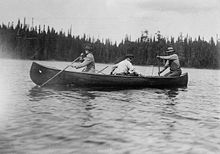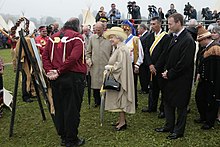Monarchy of Canada and the Indigenous peoples of Canada
[21] The proclamation set parts of the King's North American realm aside for colonists and reserved others for the First Nations, thereby affirming native title to their lands and making clear that, under the sovereignty of the Crown, the Aboriginal bands were autonomous political units in a "nation-to-nation" association with non-native governments,[24][25] with the monarch as the intermediary.[31] The duty derives "from the Crown's assertion of sovereignty in the face of prior Aboriginal occupation"[32] and is "not a mere incantation, but, rather, a core precept that finds its application in concrete practices",[33] and "cannot be interpreted narrowly or technically".[48] Since as early as 1710, Indigenous leaders have met to discuss treaty business with royal family members or viceroys in private audience and many continue to use their connection to the Crown to further their political aims.[55] The latter request was passed by Anne to the Archbishop of Canterbury, Thomas Tenison, and a chapel was eventually built in 1711 at Fort Hunter, near present-day Johnstown, New York, along with the gift of a reed organ and a set of silver chalices in 1712.In 1763, George III issued a royal proclamation that acknowledged the First Nations as autonomous political units and affirmed their title to their lands; it became the main document governing the parameters of the relationship between the sovereign and Indigenous subjects in North America.[55][64] New treaties were drafted and those Indigenous nations that had lost their territories in the United States, or simply wished to not live under the US government, were granted new land in Canada by the King.[66] (Though, the Indigenous allies were not permitted to send representatives to the negotiations for the Treaty of Ghent[66] and, while the British tried to bargain for the creation of an Iroquoian state south of the Great Lakes, the American delegates refused to agree.[68] When Governor General John Campbell, Marquess of Lorne, and his wife, Princess Louise, a daughter of Queen Victoria, visited British Columbia in 1882, they were greeted upon arrival in New Westminster by a flotilla of local Indigenous peoples in canoes who sang songs of welcome before the royal couple landed and proceeded through a ceremonial arch built by Indigenous people, which was hung with a banner reading "Clahowya Queenastenass", Chinook Jargon for "Welcome Queen's Child".More treaties were signed between 1871 and 1921, wherein the Crown brokered land exchanges that granted the Indigenous societies reserves and other compensation, such as livestock, ammunition, education, health care, and certain rights to hunt and fish.[76] In 1959, the Queen toured Canada and, in Labrador, she was greeted by the Chief of the Montagnais and given a pair of beaded moose-hide jackets; at Gaspé, Quebec, she and her husband, the Duke of Edinburgh, were presented with deerskin coats by two local Indigenous people; and, in Ottawa, a man from the Kahnawake Mohawk Territory passed to officials a 200-year-old wampum as a gift for Elizabeth.Across the prairies, First Nations were present on the welcoming platforms in numerous cities and towns, and at the Calgary Stampede, more than 300 Blackfoot, Tsuu T'ina, and Nakoda performed a war dance and erected approximately 30 teepees, amongst which the Queen and the Duke of Edinburgh walked, meeting with various chiefs.[62] Still, during the same tour, Indigenous people were not always granted the personal time with the Queen that they desired; the meetings with First Nations and Inuit tended to be purely ceremonial affairs wherein treaty issues were not officially discussed.For instance, when Queen Elizabeth arrived in Stoney Creek, Ontario, five chiefs in full feathered headdress and a cortege of 20 braves and their consorts came to present to her a letter outlining their grievances, but were prevented by officials from meeting with the sovereign.[81] However, the Union of British Columbia Indian Chiefs, led by President George Manuel, opposed the action due to the continued exclusion of Indigenous voices from consultations and forums of debate.[82] To protest the lack of consultation and their concerns that the act would strip them of their rights and titles, the UBCIC organised the Indian Constitutional Express by chartering two trains that left Vancouver on 24 November 1980 for Ottawa.[84] Although Trudeau announced that he would extend the timetable for the Special Joint Committee on the Constitution to hear from Indigenous representatives, the leaders of the protest presented a petition and a bill of particulars directly to Schreyer.[86] After extensive negotiations with Indigenous leaders, Trudeau agreed to their demands in late January 1982 and, therefore, introduced Section 35 of the Constitution Act, which officially reaffirmed Aboriginal rights.After 178 days of public hearings, visits by 96 communities, and numerous reviews and reports, the central conclusion reached was that "the main policy direction, pursued for more than 150 years, first by colonial, then by Canadian governments, has been wrong", focusing on the previous attempts at cultural assimilation.[8] In 1994, while the Queen and her then-prime minister, Jean Chrétien, were in Yellowknife for the monarch to open the Northwest Territories Legislative Building, Bill Erasmus, the leader of the Dene community, used the opportunity to, in front of the nation's and world's cameras, present Elizabeth with a list of grievances over stalled land claim negotiations.Portraits of the Four Mohawk Kings that had been commissioned while the leaders were in London had then hung at Kensington Palace for nearly 270 years, until Queen Elizabeth II in 1977 donated them to the Canadian Collection at the National Archives of Canada, unveiling them personally in Ottawa.[101] Spence then indicated that she would boycott a conference involving other First Nations leaders and the Prime Minister because the Governor General, as a non-partisan figure, declined attendance at a policy meeting.The Privy Council Office insisted the meeting not include the Governor General, to avoid giving any impression that the viceroy had the constitutional authority to change government policy.This began with the lighting of the sacred fire at sunrise, a song by Elder Gary Sault, tobacco offerings, and a circle dance and was regarded as an important act of reconciliation.[106] I have greatly appreciated the opportunity to discuss with the Governor General the vital process of reconciliation in this country—not a one-off act, of course, but an ongoing commitment to healing, respect and understanding.[107] The following year, indigenous matters were a theme throughout the royal tour of Prince Charles and his wife, Camilla, Duchess of Cornwall, to celebrate the 70th anniversary of the accession of Elizabeth II to the Canadian throne.In his first speech of the tour, the Prince said that it was an "important moment" with "indigenous and non-indigenous peoples across Canada committing to reflect honestly and openly on the past, and to forge a new relationship for the future".[117] Federal and provincial viceroys also met with First Nations leaders for more ceremonial occasions, such as when in 1867 Canada's first governor general, the Viscount Monck, received a native chief, in full feathers, among some of the first guests at Rideau Hall.A member of the Mnjikaning First Nation, Bartleman listed the encouragement of indigenous young people as one of his key priorities and, during his time in the Queen's service, launched several initiatives to promote literacy and social bridge building, travelling to remote native communities in northern Ontario, pairing native and non-native schools, and creating the Lieutenant Governor's Book Program, which collected 1.4 million books that were flown into the province's north to stock shelves of First Nations community libraries.[129] On 6 July 2021, Prime Minister Justin Trudeau announced that Queen Elizabeth II had approved the appointment of Mary Simon as the 30th governor general of Canada.

















Monarchy of CanadaCanadian monarchical historySovereigns of Canada and their consortsMonarchy by provincesViceroysGovernor GeneralList of governors generalLieutenant governorsLGs by provincesResidencesRideau HallProvincial residences or officesSecretary to the KingSecretary to the Governor GeneralChapels royalConstitutionKing-in-CouncilKing-in-ParliamentKing-on-the-BenchKing's peaceCrown and the ForcesMonarchical debateRoyal commissionsCrown corporationsCrown copyrightKing's PrinterCrown CollectionSymbolsCanadian royal symbolsGreat Seal of CanadaRoyal Coat of Arms of CanadaRoyal eponymsRoyal monumentsRoyal patronageRoyal prefixRoyal SwansStyle and titleThrones of CanadaRoyal tours of CanadaRoyal standardsSt Edward's CrownRoyal cypherRoyal anthemLoyal toastVictoria DayCoronation DayCoronation ContingentGolden Jubilee of Queen VictoriaSilver Jubilee of George VSilver Jubilee of Elizabeth IIRuby Jubilee of Elizabeth IIGolden Jubilee of Elizabeth IIDiamond Jubilee of Elizabeth IISapphire Jubilee of Elizabeth IIPlatinum Jubilee of Elizabeth IIIndigenous peoplesin CanadaFirst NationsMétisTimelinePre-colonizationGeneticsSettler colonialismGenocideResidential schoolsIndian hospitalsReconciliationIndigenous lawBritish Columbia Treaty ProcessCrown and Indigenous peoplesHealth PolicyIdle No MoreIndian ActIndigenous and Northern Affairs CanadaLand BackLand claimsLand defenderLand titleMissing and Murdered Indigenous WomenNumbered TreatiesRoyal CommissionSelf-governmentSpecific claimsTreaty rightsIndigenous personalitiesCountry foodIndian reservesTerritoriesPacific CoastInuit languagesChinuk WawaIndigenous English DialectsAboriginal syllabicsChinuk pipaInuit grammarTraditional beliefsInuit religionIndex of articlesfirst interactionsNorth American Indigenous peoplesEuropeantreatiesMāoriTreaty of WaitangiCabinetCanadian Aboriginal lawminister of Crown–Indigenous relationsPrince ArthurSix NationsMohawk ChapelBrantfordIndigenous peoples in CanadaSupreme CourtGuerin v the Queensupportive of the monarchyLieutenant Governor of British ColumbiaIona CampagnoloAmerican RevolutionGeorge IIIRoyal Proclamation of 1763Magna CartaBritish CrownCanadian constitutionNorth Americanreserved others for the First NationssovereigntySparrow v. The Queen